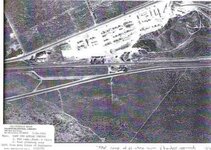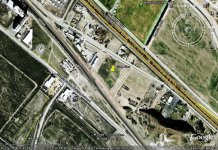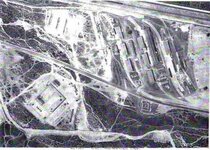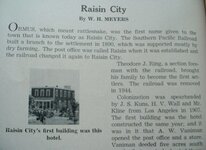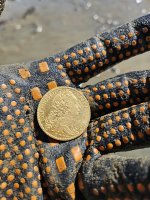pegleglooker
Bronze Member
- Jun 9, 2006
- 1,857
- 237
- Detector(s) used
- ace 250
- Primary Interest:
- All Treasure Hunting
A Short History of Camp Ono
Camp Ono is an unofficial, unrecognized name attached to a World War II supply depot which fulfilled several key functions during and immediately following World War II. Most military sources refer to the base by one of three terms: 1) the Base General Depot; 2) The Mira Loma Quartermaster Repair Sub-Depot, or 3) The San Bernardino Engineer Depot.
The chronology which follows is abstracted from a collection of histories and studies mostly prepared by the Depot Historian, James W. Bennett. Bennett prepared several monographs which are now contained in Record Group 92, Boxes 7, 8, and 10, stored in the National Archives, Pacific Southwest Region, Laguna Niguel, CA. Bennett was actually stationed at the Mira Loma Quartermaster Depot in Mira Loma, California (near Ontario in San Bernardino County). A list of references used in preparing this brief chronology follows this history, and anyone seriously interested in the history of "Camp Ono" should call the National Archive at (714) 643-4241 for an appointment to view these records.
On January 9, 1942, Lt. Col. Charles E. Stafford arrived in San Bernardino and assumed command of the organization which became the Advance Communications Zone Depot, under the command and control of the Army Ninth Service Command, headquartered at Fort Douglas, Utah. The Depot was established on January 16, 1942, with administrative offices in the Andreson Bldg. at 3rd and E Streets in San Bernardino. Warehouses were leased in a variety of locations in San Bernardino, including the National Orange Show. Over the next month or two, a search was conducted to locate a suitable open space for creating a supply depot, with requirements including access to railroads and highways.
The Ono siding was selected, with approximately 1,100 acres leased by the United States, primarily from the Muscoy Water Company. (A map showing the leased parcels is available in Record Group 77, Box 1, Records of the Corps of Engineers, in the National Archive in Laguna Niguel.) A contract to construct warehouses and buildings was awarded on February 11, and construction began February 12, 1942, according to the Depot Military Diary. The Corps of Engineers also claims credit for building many of the structures at the Depot. Soon after, in March, 1942, the Depot began storing supplies, both at the Ono siding and in warehouses around San Bernardino, including one reference to 80,000 gallons of oil, requiring 10 acres of open ground, and drums of lubricants, requiring 800 square feet of storage space, a task which seemed impossible to Stafford, but which was done.
On April 2, 1942, the Desert Training Center was established, headquartered at Camp Young in the Mojave Desert, with Major General George S. Patton, Jr. in command. For the next two to three years, one of the primary functions of the Ono Depot was to supply the troops assigned to the Desert Training Center (DTC), which was later renamed the California-Arizona Maneuver Area (CAMA). On April 15, 1942 the Ono Depot was detached from the Communications Zone and redesignated as a branch of the California Quartermaster Depot located in Oakland, CA. By May 1, 1942, the Administration building at Ono was completed and the Depot headquarters was moved to the Kendall Avenue address. The Bennett monographs report that the move was not accomplished without incident however. Apparently some strong Santa Ana winds shifted the building approximately 4 inches off its foundations, and a moderate earthquake also caused the building's roof to separate from the walls, requiring repair and additio!
nal bracing.
By July 1, 1942, the Depot was assigned responsibility for supplying "subsistence" (everything other than ordnance) to the DTC (which quickly grew to a maximum of some 200,000 troops), as well as rations for the Japanese civilians interned after the outbreak of hostilities, totalling between 40,000 and 60,000 people incarcerated at Camp Manzanar in the Owens Valley, California, Parker, Arizona, and other locations. On August 15, 1942, another change in the command structure occurred with the Ono Depot made a Sub-Depot of the Mira Loma Quartermaster Depot, a facility then under construction, and returned to the direct control of the 9th Service Command in Utah. By December, 1942, it was decided to make the Sub-Depot an "on the job" training experience for troops and commanders going overseas, in order to provide them with experience in setting up and running a supply depot overseas.
Accordingly, the Sub-Depot was established as a Training Theater of Operations Depot, renamed the Base General Depot, and administrative and supply units were cycled through to gain actual experience in supplying front line troops. The BGD continued to supply all classes of commodities except ordnance, including quartermaster, signal corps, and engineer supplies until the C-AMA was closed in April 1944. At its busiest, the BGD was designed to accommodate 15,000 field troops, had a field hospital with 1,100 beds (cots?) at the northwest end of the camp, a laundry which peaked at laundering 40,000 items in an 8 hour shift, clothing repair shops, and 13,000+ feet of railroad track laid by the Corps of Engineers to supplement the AT & SF/Union Pacific tracks.
An oversized map of the Depot, with buildings located and numbered, is included with the Corps of Engineers material on deposit at the Laguna Niguel Archive On June 7, 1944, the BGD was deactivated and control of the Depot was split, with 380 acres assigned to the Quartermaster Corps and designated the Mira Loma Quartermaster Repair Sub-Depot. The Depot's primary mission was repairing clothing and equipment, particularly tents, canvas products, and webbing gear from a variety of sources, both overseas and from the disbanded C-AMA.
Repaired material was sent to Mira Loma, and from there went to troops overseas, either in Europe or the Pacific theater. The balance of the Depot was assigned to the Corps of Engineers, designated the San Bernardino Engineers Depot, and was used primarily for the storage of mobile drilling rigs and petroleum refineries, as well as receiving, repairing, and shipping of construction equipment. 1,360 tractors were also received, modified for military use, and shipped overseas.
A major portion of the tent repair mission was accomplished by former Italian POWs. After the fall of Italy, the government of Italy joined the Allied Forces against Germany, and Italian POWs were offered the option of swearing loyalty to the new Italian government and non-aggression against the United States. Most POWs elected to do so, and were then placed in special military units, called I.S.U.s or Italian Service Units. Four companies were assigned to the Repair Sub-Depot, and devoted most of their efforts to repairing and refurbishing material for reuse in the war effort, including tents, stoves, vehicles, and other non-perishable supplies. The ISUs at the Sub-Depot, once they were appropriately trained and given adequate facilities, proved to be invaluable, contributing numerous suggestions and improvements to the repair process, maintaining much of the Sub-Depot equipment, and providing almost all of the heavy manual labor required.
Bennett's monographs deal in some length with the primitive conditions at the Sub-Depot, including the lack of paved roads, buildings without air conditioning, coolers, or even ventilation, lack of sanitary facilities, particularly for women, which made hiring and retention of civilian employees difficult. In addition, transportation to the base was often difficult, especially with gasoline rationing, and some commuters suffered damage to their vehicles from windblown sand. Moreover, with labor scarce, many workers preferred to work in better conditions in town, at higher paying jobs. The Depot was unable to match wages paid by non-military employers. All of these circumstances, which created a civilian labor shortage, made the work of the ISUs even more valuable.
By November, 1945, the ISUs had been disbanded and repatriated to Italy. The QMC declared the Sub-Depot surplus, having moved all operations to Mira Loma, and the base was completely occupied by the Engineers. On June 30, 1947, the San Bernardino Engineers Depot was deactivated, with virtually all surplus material at the Depot sold in one or another of the nine sales of surplus property, or shipped to another base for use or sale.
Location:The former San Bernardino Engineer Depot consisted of 1662.82 acres and is located 4 miles northwest of San Bernardino bounded by Kendall Drive, Cajon Boulevard, and Little League Avenue with the Interstate Freeway running through the center of the property parallel with Cajon Boulevard. A second separate parcel of land is bound by 3rd Avenue on the north, First Avenue on the south, Gary Street on the west, and Nolan Street on the east. A third separate parcel of land is located between the Southern Pacific Railway on the east, Cajon Boulevard on the west, Institution Road on the north, and running approximately one mile to the southern boundary. A fourth parcel of land occupies an area a quarter of a mile north of Little League Drive and up to Yucca Avenue between the Union Pacific Railroad and Cajon Boulevard. A fifth parcel lies a quarter of a mile north of the fourth parcel and is bounded by Cajon Boulevard on the east, the Union Pacific Railroad on the south where the railroad and road cross each other. Camp Ono occupied approximately 300 acres within the Depot. Camp Ono was located between Cajon Boulevard and Kendall Drive and was considered part of the San Bernardino Engineer Depot.
Camp Ono is an unofficial, unrecognized name attached to a World War II supply depot which fulfilled several key functions during and immediately following World War II. Most military sources refer to the base by one of three terms: 1) the Base General Depot; 2) The Mira Loma Quartermaster Repair Sub-Depot, or 3) The San Bernardino Engineer Depot.
The chronology which follows is abstracted from a collection of histories and studies mostly prepared by the Depot Historian, James W. Bennett. Bennett prepared several monographs which are now contained in Record Group 92, Boxes 7, 8, and 10, stored in the National Archives, Pacific Southwest Region, Laguna Niguel, CA. Bennett was actually stationed at the Mira Loma Quartermaster Depot in Mira Loma, California (near Ontario in San Bernardino County). A list of references used in preparing this brief chronology follows this history, and anyone seriously interested in the history of "Camp Ono" should call the National Archive at (714) 643-4241 for an appointment to view these records.
On January 9, 1942, Lt. Col. Charles E. Stafford arrived in San Bernardino and assumed command of the organization which became the Advance Communications Zone Depot, under the command and control of the Army Ninth Service Command, headquartered at Fort Douglas, Utah. The Depot was established on January 16, 1942, with administrative offices in the Andreson Bldg. at 3rd and E Streets in San Bernardino. Warehouses were leased in a variety of locations in San Bernardino, including the National Orange Show. Over the next month or two, a search was conducted to locate a suitable open space for creating a supply depot, with requirements including access to railroads and highways.
The Ono siding was selected, with approximately 1,100 acres leased by the United States, primarily from the Muscoy Water Company. (A map showing the leased parcels is available in Record Group 77, Box 1, Records of the Corps of Engineers, in the National Archive in Laguna Niguel.) A contract to construct warehouses and buildings was awarded on February 11, and construction began February 12, 1942, according to the Depot Military Diary. The Corps of Engineers also claims credit for building many of the structures at the Depot. Soon after, in March, 1942, the Depot began storing supplies, both at the Ono siding and in warehouses around San Bernardino, including one reference to 80,000 gallons of oil, requiring 10 acres of open ground, and drums of lubricants, requiring 800 square feet of storage space, a task which seemed impossible to Stafford, but which was done.
On April 2, 1942, the Desert Training Center was established, headquartered at Camp Young in the Mojave Desert, with Major General George S. Patton, Jr. in command. For the next two to three years, one of the primary functions of the Ono Depot was to supply the troops assigned to the Desert Training Center (DTC), which was later renamed the California-Arizona Maneuver Area (CAMA). On April 15, 1942 the Ono Depot was detached from the Communications Zone and redesignated as a branch of the California Quartermaster Depot located in Oakland, CA. By May 1, 1942, the Administration building at Ono was completed and the Depot headquarters was moved to the Kendall Avenue address. The Bennett monographs report that the move was not accomplished without incident however. Apparently some strong Santa Ana winds shifted the building approximately 4 inches off its foundations, and a moderate earthquake also caused the building's roof to separate from the walls, requiring repair and additio!
nal bracing.
By July 1, 1942, the Depot was assigned responsibility for supplying "subsistence" (everything other than ordnance) to the DTC (which quickly grew to a maximum of some 200,000 troops), as well as rations for the Japanese civilians interned after the outbreak of hostilities, totalling between 40,000 and 60,000 people incarcerated at Camp Manzanar in the Owens Valley, California, Parker, Arizona, and other locations. On August 15, 1942, another change in the command structure occurred with the Ono Depot made a Sub-Depot of the Mira Loma Quartermaster Depot, a facility then under construction, and returned to the direct control of the 9th Service Command in Utah. By December, 1942, it was decided to make the Sub-Depot an "on the job" training experience for troops and commanders going overseas, in order to provide them with experience in setting up and running a supply depot overseas.
Accordingly, the Sub-Depot was established as a Training Theater of Operations Depot, renamed the Base General Depot, and administrative and supply units were cycled through to gain actual experience in supplying front line troops. The BGD continued to supply all classes of commodities except ordnance, including quartermaster, signal corps, and engineer supplies until the C-AMA was closed in April 1944. At its busiest, the BGD was designed to accommodate 15,000 field troops, had a field hospital with 1,100 beds (cots?) at the northwest end of the camp, a laundry which peaked at laundering 40,000 items in an 8 hour shift, clothing repair shops, and 13,000+ feet of railroad track laid by the Corps of Engineers to supplement the AT & SF/Union Pacific tracks.
An oversized map of the Depot, with buildings located and numbered, is included with the Corps of Engineers material on deposit at the Laguna Niguel Archive On June 7, 1944, the BGD was deactivated and control of the Depot was split, with 380 acres assigned to the Quartermaster Corps and designated the Mira Loma Quartermaster Repair Sub-Depot. The Depot's primary mission was repairing clothing and equipment, particularly tents, canvas products, and webbing gear from a variety of sources, both overseas and from the disbanded C-AMA.
Repaired material was sent to Mira Loma, and from there went to troops overseas, either in Europe or the Pacific theater. The balance of the Depot was assigned to the Corps of Engineers, designated the San Bernardino Engineers Depot, and was used primarily for the storage of mobile drilling rigs and petroleum refineries, as well as receiving, repairing, and shipping of construction equipment. 1,360 tractors were also received, modified for military use, and shipped overseas.
A major portion of the tent repair mission was accomplished by former Italian POWs. After the fall of Italy, the government of Italy joined the Allied Forces against Germany, and Italian POWs were offered the option of swearing loyalty to the new Italian government and non-aggression against the United States. Most POWs elected to do so, and were then placed in special military units, called I.S.U.s or Italian Service Units. Four companies were assigned to the Repair Sub-Depot, and devoted most of their efforts to repairing and refurbishing material for reuse in the war effort, including tents, stoves, vehicles, and other non-perishable supplies. The ISUs at the Sub-Depot, once they were appropriately trained and given adequate facilities, proved to be invaluable, contributing numerous suggestions and improvements to the repair process, maintaining much of the Sub-Depot equipment, and providing almost all of the heavy manual labor required.
Bennett's monographs deal in some length with the primitive conditions at the Sub-Depot, including the lack of paved roads, buildings without air conditioning, coolers, or even ventilation, lack of sanitary facilities, particularly for women, which made hiring and retention of civilian employees difficult. In addition, transportation to the base was often difficult, especially with gasoline rationing, and some commuters suffered damage to their vehicles from windblown sand. Moreover, with labor scarce, many workers preferred to work in better conditions in town, at higher paying jobs. The Depot was unable to match wages paid by non-military employers. All of these circumstances, which created a civilian labor shortage, made the work of the ISUs even more valuable.
By November, 1945, the ISUs had been disbanded and repatriated to Italy. The QMC declared the Sub-Depot surplus, having moved all operations to Mira Loma, and the base was completely occupied by the Engineers. On June 30, 1947, the San Bernardino Engineers Depot was deactivated, with virtually all surplus material at the Depot sold in one or another of the nine sales of surplus property, or shipped to another base for use or sale.
Location:The former San Bernardino Engineer Depot consisted of 1662.82 acres and is located 4 miles northwest of San Bernardino bounded by Kendall Drive, Cajon Boulevard, and Little League Avenue with the Interstate Freeway running through the center of the property parallel with Cajon Boulevard. A second separate parcel of land is bound by 3rd Avenue on the north, First Avenue on the south, Gary Street on the west, and Nolan Street on the east. A third separate parcel of land is located between the Southern Pacific Railway on the east, Cajon Boulevard on the west, Institution Road on the north, and running approximately one mile to the southern boundary. A fourth parcel of land occupies an area a quarter of a mile north of Little League Drive and up to Yucca Avenue between the Union Pacific Railroad and Cajon Boulevard. A fifth parcel lies a quarter of a mile north of the fourth parcel and is bounded by Cajon Boulevard on the east, the Union Pacific Railroad on the south where the railroad and road cross each other. Camp Ono occupied approximately 300 acres within the Depot. Camp Ono was located between Cajon Boulevard and Kendall Drive and was considered part of the San Bernardino Engineer Depot.


